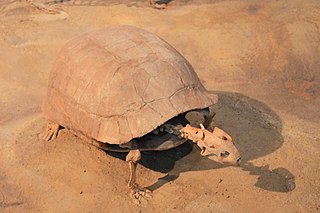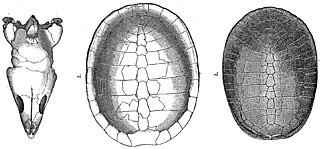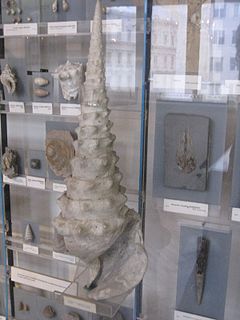
A fossil is any preserved remains, impression, or trace of any once-living thing from a past geological age. Examples include bones, shells, exoskeletons, stone imprints of animals or microbes, objects preserved in amber, hair, petrified wood, oil, coal, and DNA remnants. The totality of fossils is known as the fossil record.

Ammonoids are a group of extinct marine mollusc animals in the subclass Ammonoidea of the class Cephalopoda. These molluscs, commonly referred to as ammonites, are more closely related to living coleoids than they are to shelled nautiloids such as the living Nautilus species. The earliest ammonites appear during the Devonian, and the last species vanished in the Cretaceous–Paleogene extinction event.

Gryphaea, common name devil's toenails, is a genus of extinct oysters, marine bivalve mollusks in the family Gryphaeidae.

Nautiloids are a large and diverse group of marine cephalopods (Mollusca) belonging to the subclass Nautiloidea that began in the Late Cambrian and are represented today by the living Nautilus and Allonautilus. Nautiloids flourished during the early Paleozoic era, where they constituted the main predatory animals, and developed an extraordinary diversity of shell shapes and forms. Some 2,500 species of fossil nautiloids are known, but only a handful of species survive to the present day.

Chelodina, collectively known as snake-necked turtles, is a large and diverse genus of long-necked chelid turtles with a complicated nomenclatural history. Although in the past, Macrochelodina and Macrodiremys have been considered separate genera and prior to that all the same, they are now considered subgenera of the Chelodina, further Macrochelodina and Macrodiremys are now known to apply to the same species, hence Chelydera is used for the northern Snakeneck Turtles.

Cypraeoidea, the cowries and cowry allies, is a superfamily of sea snails, marine gastropods included in the clade Littorinimorpha. This superfamily had been called Cypraeacea and was named by Rafinesque in 1815.

Pohlsepia mazonensis is the earliest described octopod, originating from the late Carboniferous period. The species is known from a single exceptionally preserved fossil discovered in the Pennsylvanian Francis Creek Shale of the Carbondale Formation, north-east Illinois, United States.

The lightning whelk, scientific name Sinistrofulgur perversum, is an edible species of very large predatory sea snail or whelk, a marine gastropod mollusc in the family Busyconidae, the busycon whelks. This species has a left-handed or sinistral shell. It eats mostly bivalves.

Stylemys is the first fossil genus of dry land tortoise belonging to the order Testudines discovered in the United States. The genus lived in temperate to subtropical areas of North America, Europe, and Asia, based on fossil distribution. The genus was first described in 1851 by Joseph Leidy. The tortoise was common in the prehistoric Badlands, especially Nebraska and South Dakota. The species has also been found in the formations in and around Badlands National Park. Fossil fragments have also been found in the Palm Park Formation of New Mexico.

Glyptops is an extinct genus of cryptodire turtle dating from the Late Jurassic and Early Cretaceous periods 155 to 99 m.y.a. Fossils have been found in South Dakota, Wyoming, Colorado, Utah, New Mexico, Oklahoma, and Texas from both the Morrison and Cedar Mountain formations. The type species is G. plicatulus, which had been named Compsemys plicatulus by Edward Drinker Cope.

Mollusca is the second-largest phylum of invertebrate animals after the Arthropoda. The members are known as molluscs or mollusks. Around 85,000 extant species of molluscs are recognized. The number of fossil species is estimated between 60,000 and 100,000 additional species. The proportion of undescribed species is very high. Many taxa remain poorly studied.

Juliidae, common name the bivalved gastropods, is a family of minute sea snails, marine gastropod mollusks or micromollusks in the superfamily Oxynooidea, an opisthobranch group. These are sacoglossan (sap-sucking) sea snails, and many of them are green in color.

†Campanile giganteum is a species of exceptionally large fossil sea snail, marine gastropod molluscs in the family Campanilidae. This species dates from the Eocene epoch. With a shell length of 40 to 60 cm this is considered to be one of the largest (lengthwise) species of shelled gastropod that ever lived. It is found mostly in the Paris Basin.

Syrinx aruanus, common name the Australian trumpet or false trumpet, is a species of extremely large sea snail measuring up to 91 cm long and weighing up to 18 kg. It is a marine gastropod mollusk in the family Turbinellidae, and is the only species in the genus Syrinx.

Campanile is a genus of large sea snails, marine gastropod molluscs in the family Campanilidae.

Trionyx is a genus of softshell turtles belonging to the family Trionychidae. In the past many species in the family were classified in this genus, but today T. triunguis, the African or Nile softshell turtle, is the only extant softshell still classified as Trionyx. The other species still assigned to this genus are only known from fossils. T. triunguis is a relatively large, aquatic piscivore.

A selenizone is an anatomical structure that exists in the shells of some families of living sea snails: the slit shells, the little slit shells and the abalones, which are marine gastropod mollusks from ancient lineages.

Campanile symbolicum, common name the bell clapper or the giant creeper, is a species of large sea snail, a marine gastropod mollusc in the family Campanilidae.

Tasbacka is an extinct genus of sea turtle containing several species.

Campanile cornucopiae is a species of fossil sea snail, a marine gastropod mollusc in the family Campanilidae. This species lived during the Eocene epoch, from 56 to 33.9 million years ago.



















